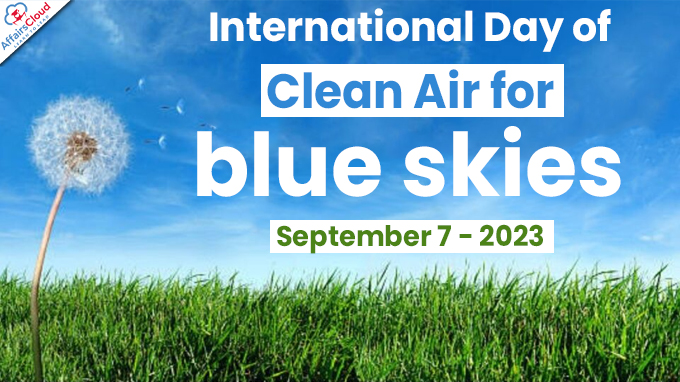
- The day also aims to mobilise global action to address air pollution, which represents one of the biggest threats to human health.
7th September 2023 marks the 4th annual observance of the International Day of Clean Air for Blue Skies.
- The theme of the International Day of Clean Air for Blue Skies 2023 is, “Together for Clean Air”.
The theme highlights the urgent need for stronger partnerships, increased investment, and shared responsibility for overcoming air pollution.
Background:
i.In 2019, the United Nations General Assembly (UNGA) on its Second Committee of the 74th session adopted the resolution A/RES/74/212, designating the 7th September of every year as the “International Day of Clean Air for Blue Skies”.
ii.The first-ever International Day of Clean Air for Blue Skies was observed on 7th September 2020.
- The resolution also invited the United Nations Environment Programme (UNEP) to facilitate the observance of the International Day of Clean Air for Blue Skies.
Air Pollution and its Impacts:
i.Air pollution is a global challenge with serious implications for both human health and the environment. Without aggressive intervention, the number of premature deaths caused by ambient air pollution is projected to increase significantly.
- By 2050, the number of premature deaths caused by ambient air pollution could increase by more than 50% by 2050
Health Impact:
Tiny, invisible particles of pollution penetrate deep into our lungs, bloodstream, and bodies. These pollutants are responsible for about one-third of deaths from stroke, chronic respiratory disease, and lung cancer, as well as one-quarter of deaths from heart attack.
Climate Impact:
Short-lived climate pollutants (SLCPs) such as black carbon, methane, tropospheric (ground-level) ozone, and hydrofluorocarbons are the most important contributors to the man-made global greenhouse effect after carbon dioxide (CO2) and have high global warming potential.
WHO Develops 1st Air Pollution & Health Training Toolkit for Health Workers
World Health Organization (WHO) has developed the 1st Air Pollution and Health Training toolkit (APHT), in collaboration with over 30 international experts, specifically tailored for health workers.
- The APHT is set to be released at the end of 2023. The APHT toolkit is a set of materials designed to enable health workers, in clinical and public health sectors.
- The purpose of APHT is to educate health workers about the health risks of air pollution and identify risk reduction strategies.
WHO launched the user-friendly OpenWHO online training program on International Day of Clean Air for Blue Skies 2023(7th September 2023) during the WHO Webinar Series – Clean air and energy for health: from evidence to solutions.
How to use APHT?
The APHT toolkit adopts a train-the-trainer approach and facilitates in-person workshops, online courses, and various learning opportunities.
- Tools provided by WHO, such as this training program, can empower local health workers in their own communities to advocate for policy reforms while counseling patients and individuals on how to reduce their exposure.
OpenWHO online training program:
i.OpenWHO online training program is the first part of the toolkit that has been introduced explicitly for healthcare professionals.
ii.This aims to equip all health workers, who would benefit from gaining knowledge and skills to protect individuals and communities from air pollution exposure.
iii.This contains 4 modules: outdoor (ambient) air pollution, household air pollution, the main health effects of air pollution exposure, and what health workers can do.
- This course examines the main health impacts of air pollution and which roles health workers can play to protect and promote people’s health.
Note: According to a report from the International Federation of Medical Students Associations (IFMSA), only 11% of medical schools worldwide include air pollution as a risk factor for health as part of formal education.
Key facts:
i.According to the WHO, Ambient (outdoor) air pollution is estimated to have caused 4.2 million premature deaths worldwide in 2019.
- Some 89% of this occurred in Low- and Middle-Income Countries (LMIC) and the greatest number in the WHO South-East Asia and Western Pacific Regions.
iii.Household (Indoor) air pollution was responsible for an estimated 3.2 million deaths per year in 2020, including over 237,000 deaths of children under the age of 5.
iv.Around 2.4 billion people worldwide (around a third of the global population) cook using open fires or inefficient stoves fuelled by kerosene, biomass (wood, animal dung, and crop waste), and coal, which generates harmful household air pollution.
v.The combined effects of ambient air pollution and household air pollution are associated with 6.7 million premature deaths annually.
- In 2014, WHO issued the first-ever health-based guidelines for Indoor air quality on clean fuels and technologies for household cooking, heating, and lighting.